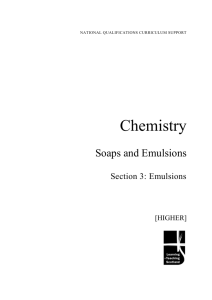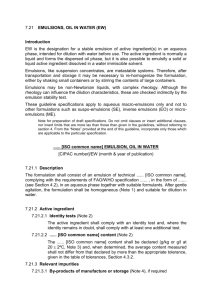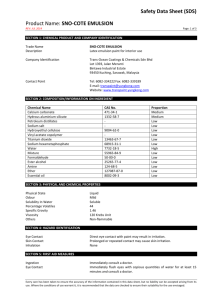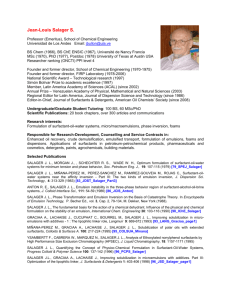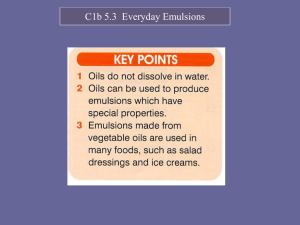Emulsion Technology Lecture 6 ACS© 2005
advertisement
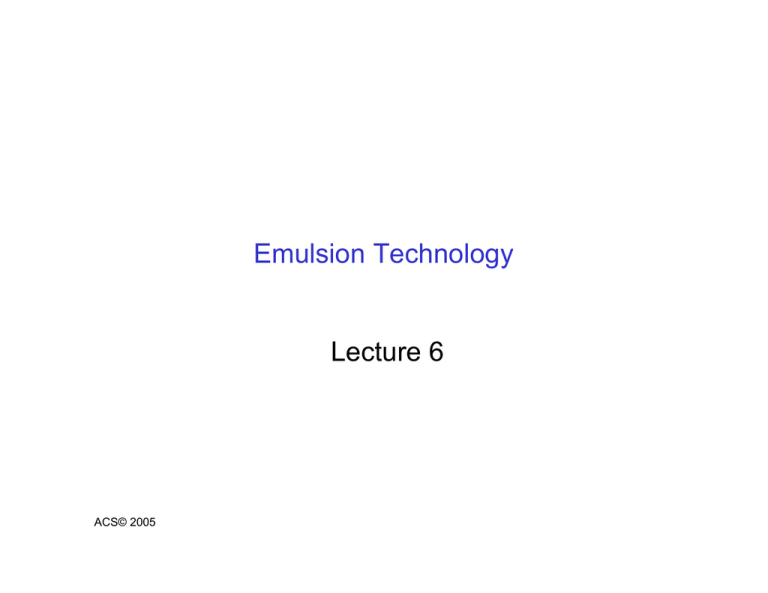
Emulsion Technology Lecture 6 ACS© 2005 Terminology -I ACS© 2005 Phase 1 Phase 2 Droplet Serum Dispersed Medium Discontinuous Continuous Internal External Lecture 6 - Emulsion Technology 1 Terminology - II Macroemulsions – At least one immiscible liquid dispersed in another as drops whose diameters generally exceed 100 nm. The stability is improved by the addition of surfactants and/or finely divided solids. Considered only kinetically stable. Miniemulsions – An emulsion with droplets between 100 and 1000 nm, reportedly thermodynamically stable. Microemulsions – A thermodynamically stable, transparent solution of micelles swollen with solubilizate. Microemulsions usually require the presence of both a surfactant and a cosurfactant (e.g. short chain alcohol). Becher, P. Emulsions, theory and practice, 3rd ed.; Oxford University Press: New York; 2001. ACS© 2005 Lecture 6 - Emulsion Technology 2 Manufacture of butter* • Milk is a fairly dilute, not very stable O/W emulsion, about 4% fat. • Creaming produces a concentrated, not very stable O/W emulsion, about 36% fat. • Gentle agitation, particularly when cool, 13 – 18 C, inverts it to make a W/O emulsion about 85% fat. • Drain, add salt, and mix well. • Voila – butter! • What remains is buttermilk. *Becher, Emulsions; Oxford; 2001, p. 291 ACS© 2005 Lecture 6 - Emulsion Technology 3 Typical food emulsions Food Milk, cream Ice cream ACS© 2005 Emulsio n type O/W O/W (aerated to foam) Dispersed phase Butterfat triglycerides partially crystalline and liquid oils. Droplet size: 1 – 10 µm Volume fraction: Milk: 3-4% Cream: 10- 30% Butterfat (cream) or vegetable, partially crystallized fat. Volume fraction of air phase: 50% Butter W/O Buttermilk: milk proteins, phospholipids, salts. Volume fraction: 16% Imitation cream (to be aerated) O/W Vegetable oils and fats. Droplet size: 1 – 5 µm. Volume fraction: 10 – 30% Coffee whiteners O/W Vegetable oils and fats. Droplet size: 1 – 5 µm. Volume fraction: 10 – 15 % Margarine and related products (low calorie spread) W/O Water phase may contain cultured milk, salts, flavors. Droplet size: 1 – 20 µm Volume fraction: 16 – 50 % Mayonnaise O/W Vegetable oil. Droplet size: 1 – 5 µm. Volume fractions: Minimum 65% (U.S. food standard.) Salad dressing O/W Vegetable oil. Droplet size: 1 – 5 µm. Volume fractions: Minimum 30% (U.S. food standard.) Stabilization factors, etc. Continuous phase Aqueous solution of milk proteins, salts, minerals, etc. Lipoprotein membrane, phospolipids, and adsorbed casein. Water and ice crystals, milk proteins, carboxydrates (sucrose, corn syrup) Approx. 85% of the water content is frozen at – 20oC. The foam structure is stabilized by agglomerated fat globules forming the surface of air cells. Butterfat triglycerides, partially crystallized and liquid oils; genuine milk fat globules are also present. Aqueous solution of proteins (casein), sucrose, salts, hydrocolloids. Aqueous solution of proteins (sodium caseinate), carbohydrates (maltodextrin, corn syrup, etc.), salts, and hydrocolloids. Edible fats and oils, partially hydrogenated, of animal or vegetable origin. Colors, flavor, vitamins. Aqueous solution of egg yolk, salt flavors, seasonings, ingredients, etc. pH: 4.0 – 4.5 Aqueous solutions of egg yolk, sugar, salt, starch, flavors, seasonings, hydrocolloids, and acidifying ingredients. pH: 3.5 – 4.0 Added surfactants act as “destabilizers” controlling fat agglomeration. Semisolid frozen phase. Water droplets distributed in semisolid, plastic continuous fat phase. Before aeration: adsorbed protein film. After aeration: the foam structure is stabilized by aggregated fat globules, forming a network around air cells; added lipophilic surfactants promote the needed fat globule aggregation. Blends of nonionic and anionic surfactants together with adsorbed proteins. The dispersed water droplets are fixed in a semisolid matrix of fat crystals; surfactants added to reduce surface tension/promote emulsification during processing. Egg yolk proteins and phosphatides. Egg yolk proteins and phosphatides combined with hydrocolloids and surfactants, where permitted by local food law. Lecture 6 - Emulsion Technology 4 Surface activity in emulsions Emulsions are dispersions of droplets of one liquid in another. Emulsifiers are soluble, to different degrees, in both phases. ACS© 2005 Lecture 6 - Emulsion Technology 5 Emulsion stability + ∆F = σ ∆ A < 0 Drops coalesce spontaneously. ∆F = σ∆A + work of desorption + If the work of desorption is high, the coalescence is prevented. ACS© 2005 Lecture 6 - Emulsion Technology 6 Stability of emulsions* Types: • Creaming – less dense phase rises • Inversion – internal phase becomes external phase • Ostwald ripening – small droplets get smaller • Flocculation – droplets stick together • Coalesence – droplets combine into larger ones *Dickenson in ”Food Structure”; Butterworths; 1988; p. 43. ACS© 2005 Lecture 6 - Emulsion Technology 7 Ripening of Emulsions Change in size distribution with aging, 0.005 M sodium oleate and octane: 1a, measured on first day; 1b, measured on third day; 1c. measured on seventh day, 0.005M cesium oleate; 2a, measured on first day; 2b measured on third day; 2c. Measured on seventh day. ACS© 2005 Lecture 6 - Emulsion Technology 8 Breaking of emulsions An emulsion system with an initial particle size of 235 nm was destabilized by dilution in a solution of an ionic surfactant opposite in sign to that of the particle charge. The three figures show the resulting distributions at times up to 4 days as reported in the figures. ACS© 2005 Lecture 6 - Emulsion Technology 9 Creaming of Emulsions 50 Height/mm 40 30 20 18 hours 43 hours 127 hours 154 hours 223 hours 10 0 0.0 0.2 0.4 0.6 Volume fraction Volume fraction at various heights and times was determined by measuring the speed of sound. ACS© 2005 Lecture 6 - Emulsion Technology 10 Stability of emulsions - II Electrostatic stabilization – at lower volume fractions Steric stabilization – at all volume fractions Additional factors – 1. Steric stabilization is enhanced by solubility in both phases: 2. Mixed emulsifiers (cosurfactants) are common. They can come from either phase. + + + 3. Temperature is important – solubility changes quickly. ACS© 2005 Lecture 6 - Emulsion Technology 11 Demulsification – breaking emulsions First, determine type, O/W or W/O. Continuous phase will mix with water or oil. • Chemical demulsification, i.e. change the HLB • Add an emulsifier of opposite type. • Add agent of opposite charge. • Freeze-thaw cycles. • Add electrolyte. Change the pH. Ion exchange • Raise temperature. • Apply electric field. • Filter through fritted glass or fibers. • Centrifugation. ACS© 2005 Lecture 6 - Emulsion Technology 12 Emulsion Inversion As the concentration increases (A) the droplets get closer until they pinch off into smaller, opposite type of emulsion (B). ACS© 2005 A B Lecture 6 - Emulsion Technology 13 Bancroft’s Rule “The emulsifier stabilizes the emulsion type where the continuous phase is the medium in which it is most soluble.” A hydrophilic solute in an O/W emulsion. The long tail on the surfactant is to represent the longer range interaction of a “hydrophilic” molecule through water. ACS© 2005 A hydrophilic solute in a W/O emulsion. Lecture 6 - Emulsion Technology 14 The HLB Schema Variation of type and amount of residual emulsion with HLB number of emulsifier. Optimum O /W Emulsion breaker Volume and type of emulsion W /O for O/W 10 HLB Optimum for W/O ACS© 2005 Lecture 6 - Emulsion Technology 15 HLB Scale Lipophilic End of Scale Stearane Steric Acid Sodium Stearate Sodium Laurate Sucrose Sodium Sulfate Soluble in oil; insoluble in water Soluble in oil; insoluble in water Soluble in oil; and in hot water Spreads on water substrate Spreads on water substrate Insoluble in oil; soluble in water Does not affect the surface tension in aqueous solution Insoluble in oil; soluble in water Nonspreading on water substrate Slightly oilsoluble; soluble in water Reduces surface tension of aqueous solutions Does not affect interfacial tension at oil– water interface Reduces interfacial tension at oil– water interface Reduces interfacial tension at oil– water interface Reduces interfacial tension at oil– water interface Does not affect interfacial tension at oil– water interface Increases interfacial tension at oil–water interface Does not stabilize emulsions Stabilizes water in oil emulsions Stabilizes either type of emulsion Stabilizes oil in water emulsions Does not stabilize emulsions Decreases the stability of emulsions 1 ___________ ACS© 2005 Hydrophilic end of scale HLB Scale Increases surface tension in aqueous solution 20 ___________ Lecture 6 - Emulsion Technology 16 Applications of the HLB Scale ACS© 2005 HLB Range Application 3.5–6 W/O emulsifier 7–9 Wetting agent 8–18 O/W emulsifier 13–15 Detergent 15–18 Solubilizer Lecture 6 - Emulsion Technology 17 Group Numbers for Calculating HLB Values GroupNumber Hydrophilic Groups HLB = 7 + ∑ ( H ) − ∑ ( L) + −OSON 3 a 38.7 - + −COOK - + −COON a N(tertiaryamine) Ester (sorbitanring) Ester (free) −COOH −OH(free) −O− −OH(sorbitanring) (−CHC 2 HO 2 −)n 21.1 19.1 9.4 6.8 2.4 2.1 1.9 1.3 0.5 0.33n Lipophilic Groups −CH− −CH2 − CH3 − =CH− (−CHCHC 3 HO 2 −)n ACS© 2005 Lecture 6 - Emulsion Technology 0.475 0.15n 18 HLB and C.M.C. 40 s o d i u m a lk y l s u lf a HLB A e r o s o l s e r ie s A t la s T w e e n s 20 A t la s S p a n s α −m o n o g l y c e 0 -1 -2 -3 -4 -5 Log C.M.C. ACS© 2005 Lecture 6 - Emulsion Technology 19 Phase inversion temperature 30oC 40oC 50oC 60oC 70oC 75oC 80oC 90oC 100oC Water Emulsion Oil www.bias-net.com/chimica/pdf/set_baglioni.pdf ACS© 2005 Lecture 6 - Emulsion Technology 20 HLB and the Phase Inversion Temperature HLB number (at 25oC) 16 Cyclohexane/Water 12 8 4 Water/Cyclohexane 0 0 30 60 90 120 Phase Inversion Temperature (oC) ACS© 2005 Lecture 6 - Emulsion Technology 21 Multiple emulsions (a) W/O/W double emulsion O/W/O double emulsion Consider, for either diagram: Each interface needs a different HLB value. The curvature of each interface is different. ACS© 2005 Lecture 6 - Emulsion Technology (Rosen, p. 313) 22 Particles as emulsion stabilizers Liquid 1 (oil) θ r θ h Liquid 2 (water) Almost all particles are only partially wetted by either phase. When particles are “adsorbed” at the surface, they are hard to remove – the emulsion stability is high. Crude oil is a W/O emulsion and is old!! ACS© 2005 Lecture 6 - Emulsion Technology 23 Physical properties of emulsions • Identification of “internal” and “external” phases; W/O or O/W • Droplet size and size distributions – generally greater than a micron • Concentration of dispersed phase – often quite high. The viscosity, conductivity, etc, of emulsions are much different than the continuous phase. • Rheology – complex combinations of viscous (flowing) elastic (when moved a little) and viscoelastic (when moved a lot) properties. • Electrical properties – useful to characterize structure. • Multiple phase emulsions – drops in drops in drops, … ACS© 2005 Lecture 6 - Emulsion Technology 24 The Variation in Emulsion Properties with Concentration Oil in water emulsion W/O Emulsion Property Polyhedral droplets Phase inversion Spherical droplets 0 10 20 30 40 50 60 70 80 90 100 Volume Fraction Oil The variation of properties of emulsions with changes in composition. If inversion occurs, there is a discontinuity in properties, as they change from one curve to the other. Above 74% there is either a phase inversion or the droplets are deformed to polyhedra. ACS© 2005 Lecture 6 - Emulsion Technology 25 Conductivity of Emulsions 0 .2 0 -1 -1 Conductivity (Ω m ) 0 .2 5 0 .1 5 O /W 0 .1 0 W /O 0 .0 5 0 .0 0 0 20 40 60 80 100 P h e n o l (% V o lu m e ) Phenol in water Inversion zone Water in Phenol The specific conductivity of aqueous potassium iodide and phenol emulsions as a function of composition (Manegold, p. 30). ACS© 2005 Lecture 6 - Emulsion Technology 26 Deflection of inner cylinder Viscosities of Two Types of Emulsion 300 Benzene in water 200 100 ? Water in benzene ? 0 0 10 20 30 40 50 60 70 80 90 100 Percent benzene ACS© 2005 Lecture 6 - Emulsion Technology 27 Interfacial viscosimeter Torsional wire supporting bicone. ser La Light reflects off mirror into detector. Mirror Position Detector Bicone suspended at oil/water interface. Stepping motor ACS© 2005 Lecture 6 - Emulsion Technology 28 Bibliography for emulsions Becher, P., Ed. Encyclopedia of emulsion technology, Vol. 1 Basic Theory, 1983; Vol. 2 Applications, 1985; Vol. 3 Basic theory, measurement, applications, 1988; Vol. 4, 1996; Marcel Dekker: New York. Becher, P.; Yudenfreund, M.N., Eds. Emulsions, Latices, and Dispersions; Marcel Dekker: New York; 1978. Becher, P. Emulsions: Theory and practice; Reinhold Publishing: New York; 1957; 3rd ed.; Oxford University Press: New York; 2001. Dickenson, E. An introduction to food colloids; Oxford University Press: New York; 1992. Dickenson, E.; McClements, D.J.; Advances in Food Colloids; Chapman & Hall: New York; 1996. Flick, E. W. Industrial surfactants; Noyes Publications: Park Ridge, NJ; 2nd ed. 1993. Lissant, K.J., Ed. Emulsions and emulsion technology; Marcel Dekker: New York; Parts 1 and 2, 1974; Part 3, 1984. McCutcheon's: Emulsifiers & Detergents, American Edition, MC Publishing: Glen Rock, NJ; (An annual publication.) Rosen, M.J. Surfactants and interfacial phenomena; John Wiley & Sons: New York; 1st ed, 1978; 2nd ed., 1989. Sherman, P, Ed. Rheology of emulsions; Macmillan Company: New York; 1963. Sherman, P., Ed. Emulsion science; Academic Press: New York; 1968. Shinoda, K.; Friberg, S. Emulsions and solubilization; John Wiley & Sons: New York; 1986. Sjöblom, J., Ed Emulsions and emulsion stability; Marcel Dekker: New York; 1996. ACS© 2005 Lecture 6 - Emulsion Technology 29


